In the heart of the jungles of Africa, there live two of nature‘s most respected and amazing creatures Gorilla Vs Black Panther : the gorilla, a robust primate with unmatched strength and intelligence, and the black panther, a stealthy, dark predator hides in shadows. Despite occupying very distinct ecological niches, a fantasized battle between these giants of the wild ignites the imagination.
What happens when strength and intelligence meets born hunter warrior? In this thrilling comparison of Gorilla vs Black Panther, we’ll explore their physical skills, behavioral patterns, survival skills, and fighting potential to determine who would come out on top in an ultimate jungle showdown.
- gorilla (Gorilla gorilla or Gorilla beringei)
- black panther (Panthera pardus – melanistic leopard or Panthera onca – melanistic jaguar)
So to Know the final winner of this legendary battle, You can keep reading till the end. The data I used in this blog post is well researched and to satisfy your curiosity I have added a winner column for each features, You may feel this like a phone review, But still you will be able to learn all features of Gorilla Vs Black Panther scientifically with this article,
Enjoy!
1. Body Specifications
| Subtopic | Gorilla | Black Panther | Winner |
|---|---|---|---|
| Scientific Name | Gorilla gorilla / G. beringei | Panthera pardus (Leopard) / Panthera onca (Jaguar) | Draw |
| Height (standing) | 1.4–1.8 m | 0.6–0.75 m at shoulder | Gorilla |
| Body Length | 1.7–1.8 m | 1.1–1.9 m | Draw |
| Average Weight | 140–200 kg (males) | 45–100 kg (leopard) / 56–158 kg (jaguar) | Gorilla (slightly) |
| Muscle Mass Percentage | ~40% | ~58% (extremely muscular felid) | Black Panther |
| Bone Density | High (adapted to strength) | Moderate (adapted to agility) | Gorilla |
| Shoulder Girdle Strength | Very strong | Strong | Gorilla |
| Limb Proportion | Longer arms for climbing | Balanced for ambush | Draw |
| Hand Structure | Opposable thumbs, gripping hands | Paw with retractable claws | Gorilla (grip) |
| Tail Presence | Absent | Present (balance aid) | Black Panther |
Topic Winner: Gorilla (6/10)
2. Coat and Coloration – Gorilla Vs Black Panther
| Subtopic | Gorilla | Black Panther | Winner |
|---|---|---|---|
| Color | Blackish to brownish-grey | Dark black (melanism) | Black Panther |
| Camouflage Ability | Low | Very high | Black Panther |
| Hair Density | Thick | Dense but shorter | Gorilla |
| Hair Function | Insulation | Stealth, moderate insulation | Draw |
| Shedding Pattern | Minimal | Seasonal | Draw |
| Melanin Levels | Normal | High (melanistic gene expression) | Black Panther |
| Shine in Moonlight | Low | Almost invisible | Black Panther |
| Heat Management | Effective in shade | Efficient for nocturnal hunting | Black Panther |
| Pattern Visibility | Absent | Rosettes sometimes visible | Black Panther |
| Grooming Behavior | Frequent (social grooming) | Occasional | Gorilla |
Topic Winner: Black Panther (7/10)
3. Habitat and Range
| Subtopic | Gorilla | Black Panther | Winner |
|---|---|---|---|
| Geographic Range | Central Africa | Africa, Asia, South America (jaguar) | Black Panther |
| Habitat Type | Tropical forests | Rainforests, swamps, mountains | Black Panther |
| Altitude Range | 500–3,800 meters | Sea level to 4,500 meters | Black Panther |
| Habitat Adaptability | Low to moderate | Very high | Black Panther |
| Climate Preference | Humid, equatorial | Wide range | Black Panther |
| Den/Nest Construction | Ground nests | Dens, trees, caves | Black Panther |
| Day/Night Activity | Diurnal | Nocturnal | Draw |
| Range Size | 10–20 km² | Up to 150 km² (males) | Black Panther |
| Home Territory Defense | High | Very high | Draw |
| Human Proximity Tolerance | Low | Moderate | Black Panther |
Topic Winner: Black Panther (8/10)
4. Diet and Hunting – Gorilla Vs Black Panther
| Subtopic | Gorilla | Black Panther | Winner |
|---|---|---|---|
| Diet Type | Herbivorous | Carnivorous | Black Panther |
| Main Food | Fruits, stems, leaves | Deer, monkeys, boars | Black Panther |
| Hunting Technique | Not applicable (non-predatory) | Ambush predator | Black Panther |
| Bite-to-Kill Method | None | Neck bite or skull crush (esp. jaguar) | Black Panther |
| Hunting Success Rate | Not applicable | 30–60% depending on species | Black Panther |
| Tool Use | Occasionally (sticks, stones) | None | Gorilla |
| Daily Caloric Intake | 2,000–5,000 kcal | 3,000–4,500 kcal | Draw |
| Intelligence in Feeding | High | Moderate | Gorilla |
| Predatory Aggression | None | Very high | Black Panther |
| Digestion Efficiency | Moderate (fermentation) | High (meat processing) | Black Panther |
Topic Winner: Black Panther (7/10)
5. Strength and Bite Force
| Subtopic | Gorilla | Black Panther | Winner |
|---|---|---|---|
| Bite Force (PSI) | ~1,300 PSI | ~650 PSI (leopard), ~1,500 PSI (jaguar) | Black Panther (Jaguar) |
| Claw Strength | No claws | Strong retractable claws | Black Panther |
| Arm Strength | Extremely strong arms (600–1,800 kg force) | Moderate | Gorilla |
| Lifting Capacity | Up to 800 kg | Up to 100–150 kg | Gorilla |
| Grip Strength | ~400 kg (single hand) | Weak (uses jaws and claws) | Gorilla |
| Jaw Structure | Heavy mandibles for chewing | Sharp canines for meat-slicing | Draw |
| Neck Strength | Strong | Strong (especially in jaguars) | Draw |
| Back Muscle Power | Extremely well-developed | Athletic but less bulky | Gorilla |
| Upper Body Force | Superior due to knuckle-walking | Lean and agile | Gorilla |
| Claw Damage Potential | None | High (can lacerate deeply) | Black Panther |
Topic Winner: Gorilla (6/10)
6. Speed and Agility – Gorilla Vs Black Panther
| Subtopic | Gorilla | Black Panther | Winner |
|---|---|---|---|
| Top Speed | ~40 km/h (short bursts) | 58–64 km/h (leopard) | Black Panther |
| Acceleration | Moderate | Rapid burst acceleration | Black Panther |
| Tree Climbing Ability | Excellent | Excellent | Draw |
| Swimming Skill | Poor | Strong swimmer (esp. jaguar) | Black Panther |
| Reflex Time | Slower | Very fast | Black Panther |
| Jumping Distance | 2–3 meters | Up to 6 meters (horizontal) | Black Panther |
| Agility in Forests | Moderate | High | Black Panther |
| Maneuverability | Low | High | Black Panther |
| Endurance/Stamina | Moderate | Moderate to high | Black Panther |
| Flexibility | Low to moderate | High | Black Panther |
Topic Winner: Black Panther (9/10)
7. Senses
| Subtopic | Gorilla | Black Panther | Winner |
|---|---|---|---|
| Vision (daylight) | Excellent | Moderate | Gorilla |
| Vision (night) | Poor | Exceptional | Black Panther |
| Hearing Range | ~400–6,000 Hz | 100–60,000 Hz | Black Panther |
| Olfactory Capability | Weak | Strong | Black Panther |
| Depth Perception | High | High | Draw |
| Smell-Based Tracking | Minimal | Advanced | Black Panther |
| Auditory Sensitivity | Good | Excellent | Black Panther |
| Touch Sensitivity | High (social species) | Moderate | Gorilla |
| Cognitive Awareness | Extremely high | Moderate | Gorilla |
| Response to Stimuli | Fast | Very fast | Black Panther |
Topic Winner: Black Panther (7/10)
8. Reproduction and Lifespan
| Subtopic | Gorilla | Black Panther | Winner |
|---|---|---|---|
| Gestation Period | ~8.5 months | ~3.5 months | Black Panther |
| Litter Size | 1 infant | 2–4 cubs | Black Panther |
| Reproductive Rate | Low (once every 4 years) | High (every 2 years or less) | Black Panther |
| Infant Mortality Rate | Moderate | Moderate to high | Draw |
| Parental Investment | Very high | Moderate | Gorilla |
| Age at Sexual Maturity | 10–12 years (males) | 2.5–4 years | Black Panther |
| Lifespan (wild) | 35–40 years | 12–17 years | Gorilla |
| Lifespan (captivity) | Up to 50 years | Up to 20–25 years | Gorilla |
| Interbirth Interval | Long (4–5 years) | Short (1–2 years) | Black Panther |
| Infant Dependency | 3–4 years | 1–1.5 years | Gorilla |
Topic Winner: Black Panther (6/10)
9. Social Behavior – Gorilla Vs Black Panther
| Subtopic | Gorilla | Black Panther | Winner |
|---|---|---|---|
| Social Structure | Complex troops | Solitary | Gorilla |
| Communication Methods | Vocalizations, gestures, body language | Growls, hisses, visual cues | Gorilla |
| Territorial Behavior | Moderate | Strongly territorial | Black Panther |
| Parental Care | Long-term | Moderate | Gorilla |
| Hierarchy | Alpha silverback | None (solitary) | Gorilla |
| Conflict Resolution | Ritualized display | Direct aggression | Gorilla |
| Grooming Behavior | Frequent | Rare | Gorilla |
| Cooperative Behavior | Present | Absent | Gorilla |
| Play Behavior | Common among juveniles | Rare | Gorilla |
| Intragroup Bonding | High | Absent | Gorilla |
Topic Winner: Gorilla (9/10)
10. Conservation Status
| Subtopic | Gorilla | Black Panther | Winner |
|---|---|---|---|
| IUCN Red List Status | Critically Endangered (Eastern), Endangered (Western) | Vulnerable (leopard/jaguar) | Gorilla |
| Total Wild Population | ~100,000 (all species) | ~700,000 (all melanistic big cats) | Black Panther |
| Major Threats | Habitat loss, poaching, disease | Habitat loss, illegal trade | Draw |
| Habitat Protection | Moderate | Moderate | Draw |
| Captive Breeding Success | High | Moderate | Gorilla |
| Anti-Poaching Measures | Improving | Inconsistent | Gorilla |
| Ecotourism Value | Very high | High | Gorilla |
| Conservation Funding | High | Lower than gorillas | Gorilla |
| Reintroduction Programs | Ongoing | Rare | Gorilla |
| Population Trend | Stable/increasing (protected areas) | Decreasing (in some regions) | Gorilla |
Topic Winner: Gorilla (7/10)
Face-to-Face Fight: Gorilla vs Black Panther
In a face to face fight, the gorilla would mostly win against a black panther due to its size, strength, and resilience. The panther’s agility and claws are considerable, but not enough to overcome the gorilla’s physical advantages in a direct fight.
-
The gorilla has immense strength, the ability to crush with its hands, high intelligence,
-
The black panther, especially if it’s a jaguar, is a stealth master with bone-crushing jaws and slicing claws.
If black panther ambushed, the gorilla could be seriously injured or killed, especially with a skull bite (in the case of jaguar). However, in a fair confrontation—face-to-face with full visibility—the gorilla’s superior strength and size give it the edge.
Overall Winner — Gorilla
In a direct fight, the outcome would largely depend on surprise, terrain, and tactics. But nature rarely puts these two in each other’s faces. Both thrive by becoming a virtuoso of its own brawn vs. stealth, muscle vs. intrigue. In the end, the true winners are the ecosystems they help to balance and the awe they inspire in us.
Why Gorilla Wins:
-
Greater physical strength and lifting ability.
-
High intelligence and social complexity.
-
Longer lifespan and superior conservation efforts.
-
Dominates in categories like strength, social behavior, and reproduction.
Why Black Panther Loses:
-
While agile and stealthy, lacks the raw power of a gorilla in direct combat.
-
Relies on ambush tactics which may fail in open confrontations.
-
Inferior in physical confrontation and durability.
Interesting Facts,
Gorilla Facts:
-
Gorillas share about 98.3% of human DNA—they’re our close relatives!
-
A silverback gorilla can lift over 1,800 lbs (800 kg)—that’s more than 10 average humans.
-
They are gentle giants—gorillas are mostly peaceful and shy.
-
Gorillas communicate using 20+ distinct sounds, gestures, and even facial expressions.
-
A silverback male leads a troop, acting as protector, peacekeeper, and guide.
-
Gorillas are herbivores, but they have massive canines for defense and social dominance.
-
They build nests each night from leaves and branches—yes, even the big guys!
-
Gorillas can catch human colds and flu, which can be fatal to them.
-
They live in the dense rainforests of central Africa.
-
In the wild, gorillas live up to 35–40 years; in captivity, they can exceed 50 years.
panther Black Panther Facts:
-
“Black panther” isn’t a species—it’s a melanistic leopard or jaguar.
-
Their dark coat helps them blend into dense jungles—a stealth advantage at night.
-
They’re extremely rare, especially black leopards in Africa and Asia.
-
Black panthers have rosettes (spots) like regular leopards/jaguars—they’re just hidden by dark fur.
-
Panthers are solitary and elusive—they avoid human contact more than most big cats.
-
Known for tree-climbing skills, especially black leopards which often drag prey into trees.
-
A black jaguar’s bite is strong enough to pierce turtle shells and skulls.
-
Excellent swimmers – black jaguars found in rainforests near rivers.
-
Their melanism gene might give them a vision advantage in low light.
-
In some cultures, the black panther is seen as a symbol of mystery, power, and guardianship.
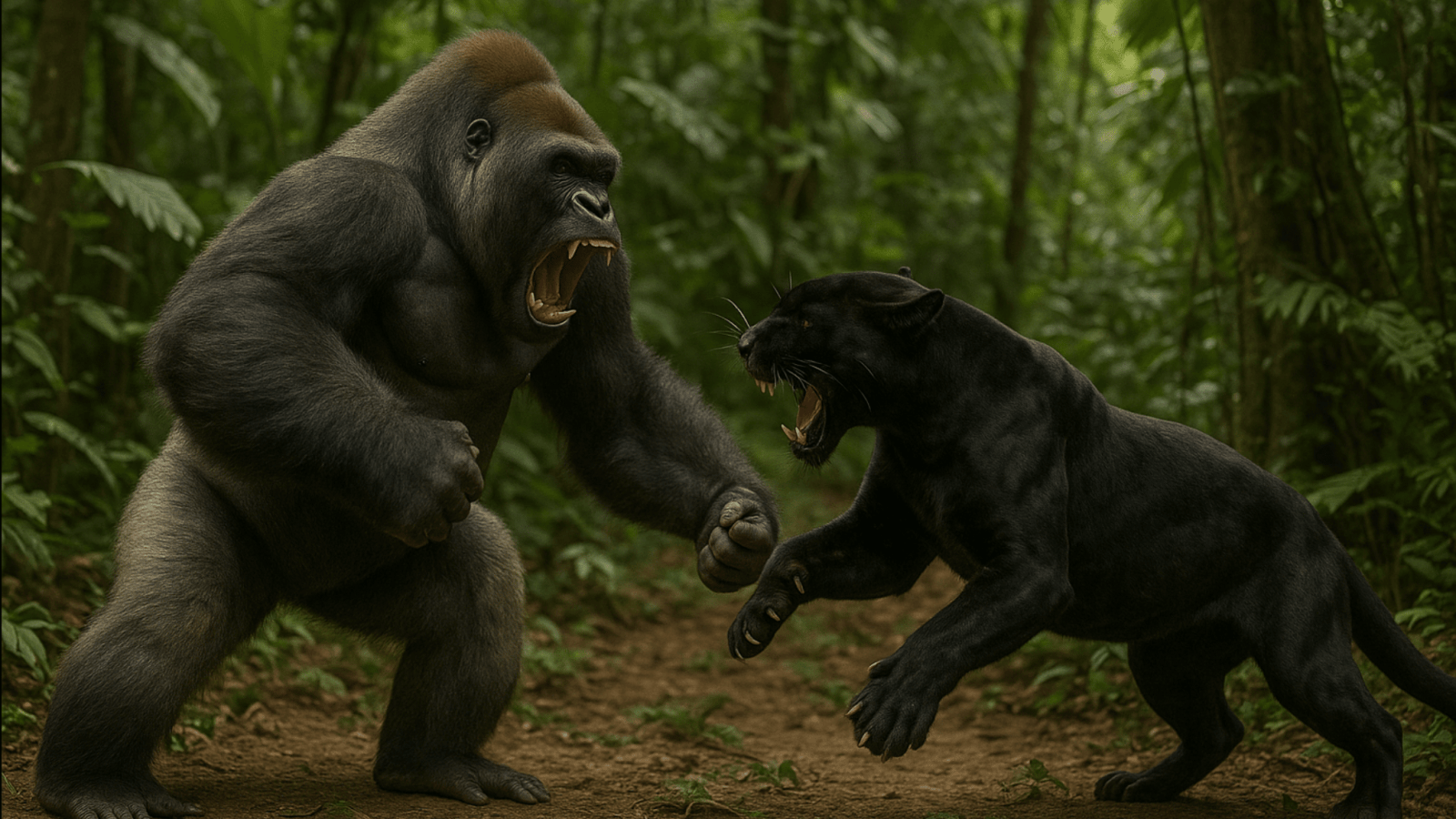
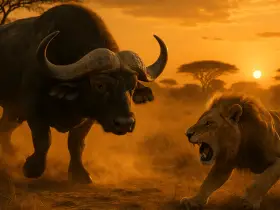
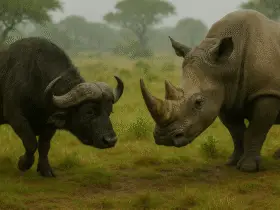
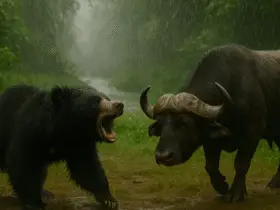
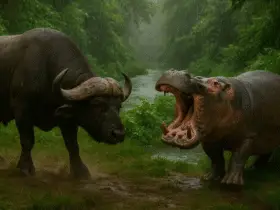
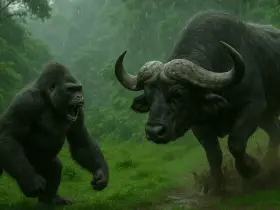
Leave a Reply